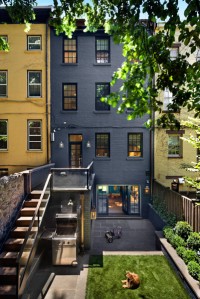 From Street Easy writer Brendan Coburn, a series of posts called the "Brownstone Rundown". From the introduction: "Typically there are two structural components that require evaluation in a row house renovation: the masonry shell (i.e. its four walls and foundation) and the wood framing. This article series will focus on the masonry component and include case studies of three townhouse renovations."
From Street Easy writer Brendan Coburn, a series of posts called the "Brownstone Rundown". From the introduction: "Typically there are two structural components that require evaluation in a row house renovation: the masonry shell (i.e. its four walls and foundation) and the wood framing. This article series will focus on the masonry component and include case studies of three townhouse renovations."
"Although Brooklyn Heights is considered one of the 'nicest' neighborhoods in the City, rowhouses in the area exhibit a wide range of construction quality. Cobble Hill, Carroll Gardens and Boerum Hill show a variety as well. Rowhouses in these neighborhoods often have real structural problems that are costly to address because they were built during the early years of the urbanization of Brooklyn. At the time, many design and engineering decisions were based on speculation and building materials were not standardized."
Brooklyn Heights Greek Revival: "This rowhouse’s original builders were excellent masons, but less than stellar carpenters. The brick masonry walls were three wythes – or brick widths – thick which is typical for this era of rowhouses. The building also had a small brick and concrete block extension that had been built long after the original house. This extension had no foundation and had settled considerably."
 Italianate Rowhouse in Carroll Gardens: "This home presented us with a nearly worst-case scenario for structural degradation. The house has a south facing garden wall which is ideal for gardening and interior sunlight, but was very damaging for the masonry. South-facing facades are particularly susceptible to degradation due to daily freeze/thaw cycles in the winter and early spring. The right way to maintain a brick wall in this environment is to re-point it every 20-40 years."
Italianate Rowhouse in Carroll Gardens: "This home presented us with a nearly worst-case scenario for structural degradation. The house has a south facing garden wall which is ideal for gardening and interior sunlight, but was very damaging for the masonry. South-facing facades are particularly susceptible to degradation due to daily freeze/thaw cycles in the winter and early spring. The right way to maintain a brick wall in this environment is to re-point it every 20-40 years."
 Prospect Heights Rowhouse: "This is almost a perfect illustration of how building practices progressed over time and exemplifies the positive effects of proper long-term care. The structure had very few framing problems, and the brick work – even on its South-facing garden façade – was in great condition. It had definitely been re-pointed at least once before."
Prospect Heights Rowhouse: "This is almost a perfect illustration of how building practices progressed over time and exemplifies the positive effects of proper long-term care. The structure had very few framing problems, and the brick work – even on its South-facing garden façade – was in great condition. It had definitely been re-pointed at least once before."
